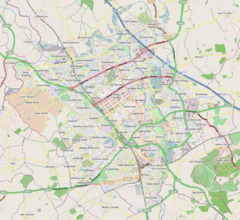| Abbey Hill | |
|---|---|
Location within Buckinghamshire | |
| Population | 4,215 [1] [a] |
| OS grid reference | SP818389 |
| Civil parish |
|
| District | |
| Unitary authority | |
| Ceremonial county | |
| Region | |
| Country | England |
| Sovereign state | United Kingdom |
| Post town | MILTON KEYNES |
| Postcode district | MK8, MK11 3 |
| Dialling code | 01908 |
| Police | Thames Valley |
| Fire | Buckinghamshire |
| Ambulance | South Central |
| UK Parliament | |
Abbey Hill is a civil parish that covers the Two Mile Ash, Kiln Farm, and Wymbush districts of Milton Keynes in Buckinghamshire, England. [2] As the first tier of Local Government, the parish council is responsible for the people, living and working in this area of Milton Keynes.
The Parish was formed in 2008 as part of a revision of parishes of the Borough of Milton Keynes:[ citation needed ] the districts were previously part of a parish called Bradwell Abbey. It is bounded by Millers Way (H2), the A5, Watling Street (V4), and Dansteed Way (H4). [3]


